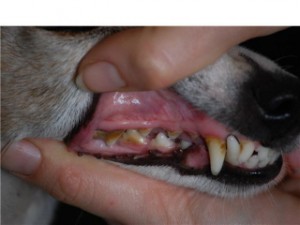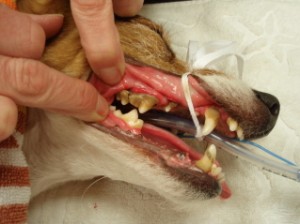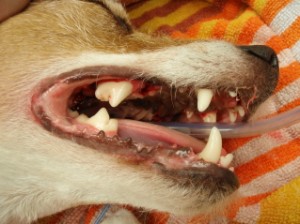Dental Problems
80% of all dogs and cats over the age of 3 have some degree of dental disease. It is a hugely common condition, which can be prevented by simple home care. Without treatment dental problems can cause sore mouths, rotten teeth and even spread infection to other places in the body.
What is dental disease?
- Dental disease is a very variable condition, it can range of a mild build up of plaque or gingivitis, to a large amount of tartar, rotten tooth roots and painful mouths.
- The bacteria that live under the tartar can spread through the body and cause damage to internal organs, so it is not just a mouth problem.
- It is very common, 80% of all dogs and cats over the age of 3 suffer from some form of dental disease.
- It is a totally preventable condition, by feeding good quality foods and cleaning your pet’s teeth regularly, you can ensure your pet doesn’t suffer.
What are the symptoms of dental disease?
- The symptoms of dental disease are variable, depending on how severe it is, but they include;
- Smelly Breath (halitosis) - not all doggy breath is inevitable!
- Sore or inflamed gums
- Plaque build up, this is a yellow build up on the smooth white enamel of the teeth.
- Tartar - this comes after the plaque, it is a hard, greeny-brown build up on the teeth.
- Mouth pain - it is not always obvious that our pets are in pain with their mouths, but dental problems are definitely painful.
- The pain from sore gums and rotten teeth is chronic ( there all the time), so it generally doesn’t stop our pets from eating, but it can make them irritable and reluctant to be handled around the mouth.
- Just because your pet is eating, does not mean they are not in pain!

This dog has moderate dental disease, with brown tartar build up on many of the teeth.
How does dental disease progress?
- The build up of plaque is the first thing in dental disease. It only takes 2 days before the plaque will reach toxic levels and start attacking the gums.
- This is why dental care is so important, and why introducing it from a very young age is also vital.
- Once the plaque as formed on the teeth, the smooth surface of the enamel has been covered, which means that the plaque can build up on itself, like rings on a tree.
- Eventually the plaque progresses to tartar. Plaque is very soft, and can be easily removed by brushing or chews, but tartar is very hard, like concrete, and therefore chews or brushing are less successful.
- Both plaque and tartar will cause the gums to become inflamed and painful. This is called gingivitis.
- Gingivitis is reversible with dental care, but if left it will progress to periodonitis which is irreversible.
- Gingivitis causes the gums to become detached from the teeth, this means bacteria can get into the root of the tooth and cause it to rot. This is periodontitis and causes irreversible damage.
- Bacteria can live on and behind the tartar and plaque. Not only does this cause bad breath (halitosis), but is also will slowly destroy the teeth, causing the roots to rot, be very sore, and eventually the tooth will drop out.
- These bacteria can also spread through the blood stream to other areas in the body. They can put great strain on the heart, liver or kidneys, and cause permanent damage. So, dental disease does not just cause problems in the mouth!
This dog has significant plaque build up but only minor tartar. These teeth could be cleaned by brushing and diet changes.
This dog has a large tartar build up on the teeth and infection is present around that tartar. These teeth need cleaning under an anaesthetic. They will be painful and the infection may spread through the body.
Preventing and Treating Dental disease
There are several different ways of treating and preventing dental disease, these range from regular brushing of your pets teeth, to feeding a high quality diet.
Brushing the teeth
- This is the best way by far of keeping your pets teeth clean, the so called ‘Gold Standard’ of dental care.
- It can be challenging to get your pet to accept having their teeth brushed, especially if they haven’t had it done since a baby, but it is not impossible, and definitely worth the effort.
- You should always use special animal toothbrushes and toothpastes; these will make the job much easier.
Toothbrushes
- There are various types of special brushes available for brushing your pets teeth. All are designed to fit easily into the animal’s mouth, remove plaque without damaging the gums, and be easy to use.
- One type of brush that can be very useful is the finger brush, this is a thimble shaped rubber brush that fits over your finger. These can be easier to use that normal brushes as they are easier to manipulate and can be more easily accepted by your pet.
Toothpastes
- It is really important that you use an animal toothpaste when you are brushing your pets teeth.
- Human toothpastes are not designed to be swallowed, and can be damaging to the stomach lining.
- Pet toothpastes are flavoured, for example with fish or chicken, so animals will take to them readily.
- Pet toothpastes do not foam like human ones, so do not worry if you are brushing your pet’s teeth and it doesn’t foam, it is still working.
- Pet toothpastes tend to be ‘enzymatic’ this means they are active on their own, and will break down the bacteria that cause the plaque and tartar. This means that you do not have to brush them on, just getting them onto your pets teeth will help, but brushing will make them work more effectively.
- They also contain ingredients which help them stick to the teeth, the longer they are in-contact with the tooth surface, the more plaque and bacteria they will be able to break down.
How to brush your pets teeth
A step by step guide of how to brush your pets teeth.
- First of all, make sure your pet is used to being handled around the mouth. When they are relaxed at home, play with their mouths, lifting their lips, stoking them and looking at their teeth. This first step is the most important, and it may take some weeks before they are totally happy.
- Next, get them used to the flavour of the pet toothpastes. The toothpastes are flavoured and most animals will take to them readily. If they like the flavour of the paste, they are much more likely to view having their teeth brushed as a treat.
- Introduce the brushing, either with a toothbrush, or a finger brush. Start with just a couple of teeth and over time progress until you are brushing all the teeth at every session. Also, try to brush all four sides of the teeth when you are brushing.
- Try to brush the teeth at least every other day. The harmful plaque that attacks the gums will build up to toxic levels in only 2 days.
- If you do brush the teeth every other day, then on the days in-between, use chews or biscuits to help keep the teeth clean.
- Always give your pet a treat after they have had their teeth brushed, and make lots of fuss of them. It will be easier for you both if your pet enjoys having their teeth brushed.
Remember
- Persevere!! It is not easy to get an animal to accept having its teeth brushed, but it is not impossible, take it slowly and keep going. The benefits are enormous.
- If the teeth bleed, don’t panic! Think how often our own teeth bleed when we brush, it never hurts does it? It is the same for animals, and as the gum health improves, the bleeding should stop.
- Make it fun! Always give you animal lots of praise and treat them after you have finished. They should find having their teeth brushed a positive experience.
- Prevention is better than cure, keeping your pets teeth clean will mean they are healthier, not in pain and can avoid veterinary dental treatment under anaesthetics in later life.
Dental Chews
- Another way of keeping the teeth clean is to use special dental chews.
- These are mainly designed for dogs, not many cats will actively use chews.
- These chews are specially shaped. They are designed to fit into a dog’s mouth and rub against the teeth, especially the molars at the back, in order to keep the teeth clean.
- The texture of the chews also helps them to stay solid and scrape the teeth clean.
- The better quality veterinary chews also contain ingredients to help prevent tartar build up. For example -
- The Royal Canin oral bars contain both a calcium chelating ingredient, which prevents calcium being available for tartar formation, and an anti-bacterial agent. Bacteria are the cause of smelly breath.
- Virbac CET dental chews contain enzymes which inhibit the plaque forming bacteria.
- Logic dental chews also contain anti-bacterial enzymes, which prevent plaque build up and halitosis.
- Feeding one good quality chew a day should help keep a dog’s teeth clean.
- Ensure that you cut back a little on your dogs regular meals if you are feeding chews, otherwise they may gain weight.
Teeth Cleaning Biscuits
- There are both prescription and more ordinary biscuits available for dental care on the market.
- Dental diets contain;
- Large kibbles, which means they engulf the teeth as they sink into them, and help to scrape them clean.
- Kibbles made from a fibre ‘matrix’, which means instead of shattering like normal biscuits as the cat or dog bites, they hold their shape, again meaning they scrape the teeth clean.
- Slightly low levels of protein and calcium, both of which are needed for plaque and tartar to form.
- These diets can be helpful for dogs who don’t like to chew, and also for cats.
- They do not need to be fed as 100% of the diet, replace a handful of your pets normal food with a handful of teeth cleaning biscuits every day.
- The better quality diets, such as Royal Canin, Hills or Proplan, are often designed with dental care as well as nutrition in mind. Feeding these diets will help to keep the teeth clean, without you having to do anything at all!
There are different makes of teeth cleaning biscuits on the market, just feeding a few a day can make a real difference. Also, premium veterinary foods are designed with dental care in mind, so feeding other biscuits with them is not always necessary.
Oral Gels and Mouth Washes
Both these products are anti-plaque and will help to keep the teeth clean, but are best used in conjunction with other methods.
Oral gels
- The oral gels are essentially toothpastes but can be used both with and without brushing.
- The gels will stick to the teeth, prolonging the contact they have with the teeth, so their ingredients have a chance to work.
- They are usually enzymatic, which means they are able to break down the bacteria which cause halitosis and plaque formation.
- They will also usually contain ‘Chlorhexidine’, which is similar to the pink liquid your dentist will use. It is an anti-plaque agent.
- The gels can be applied to your pets mouth either by hand, or some come with long applicator nozzels, which you can slip into your pets mouth and apply the gel directly to the teeth.
Mouth Washes
- Mouth washes can either be added to your pets drinking water, or applied directly into their mouths.
- They also will contain ‘Chlorhexidine’ which will break down the plaque.
- They will also often contain ingredients to help keep your pets breath smelling fresh.
- Some types come in bottles will long applicator nozzles, which make it easier for you to apply them directly into your pet’s mouth.
Plaque-off - teeth cleaning powder
- This is a relatively new addition to the market, but has been proving very popular.
- The powder is a seaweed derivative, so it is a totally natural product.
- It has been used in human dentistry for several years, in tablet form.
- The powder makes the plaque and tartar build up on the teeth much softer, which means that dental chews and biscuits are more successful at removing it.
- The powder is sprinkled on the food every day. It can be given to animals on 100% dry diets, but it is particularly useful for those who eat some soft food.
- The amount needed every day is tiny, which means that your pet won’t notice it is there, and also means it is very economical.
- A pot tends to retail at about £10, and will last a cat a year, and the average dog around 6 months.
- Plaque-off is designed to be used in conjunction with other teeth cleaning methods such as brushing or chews, just on its own it won’t be as successful.
Plaque-off is a powder made from seaweed. It is sprinkled on the food and makes the tartar and plaque on the teeth soft, meaning chews or brushing are more successful
Veterinary Dental Care
- It is often necessary for animals to undergo veterinary treatment on their teeth.
- There are several reasons why an animal might need this;
- Tartar build-up - this is often so thick that it cannot be removed by chews or brushing
- The tooth roots have become rotten, so the teeth are painful and infected
- Some animals have very sensitive mouths and even moderate build-ups of plaque can cause painful, swollen gums, and the best way to remove plaque is by veterinary dentistry
- Some young dogs, especially the toy breeds, do not shed their baby teeth. These need to be removed by the vet as they are a perfect place for plaque and tartar accumulate.
- Your vet will be able to quickly examine your pets teeth and decide if any treatment is necessary
- If your pet has a dental at the vets, they will need to undergo a General Anaesthetic. Your vet will talk you through the procedure, and advise you on the best approach.
- Dentals are often performed on older animals and general anaesthetics can carry higher risks in older pets. Your vet will do all they can to keep it as safe as possible, and may suggest blood tests or intravenous fluids to support your pet though the procedure.
- During a dental operation, a vet may perform several tasks;
- Extractions - your vet will remove any teeth that might be painful, have exposed or rotten roots or significant ‘gum regression’ - this is where the gum has died back from around the tooth causing it to loosen or the root to be exposed.
- X-rays - vets may x-ray your pets jaw and see the tooth roots, this will allow them to decide if teeth need to be removed or not.
- Scaling - plaque and tartar are removed with an ultrasonic scaler.
- Polishing - once the teeth have been scaled, they are then polished. This smoothes any small scratches on the teeth surface that may allow plaque to take purchase.
- There are now several referral veterinary dentists in the UK who are able to perform more complex procedures such as root canals and placing crowns.


These pictures show the same dog before and after dental work under a general anaesthetic. You can see the tartar has been removed and some teeth have been extracted. The remaining teeth have also been scaled and polished.
Please note, this is an advice only website, if you have any specific concerns or queries about your pet, you must speak to you vet.